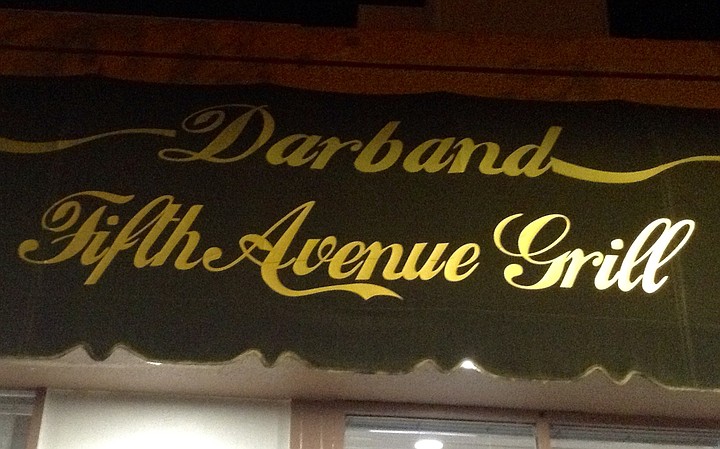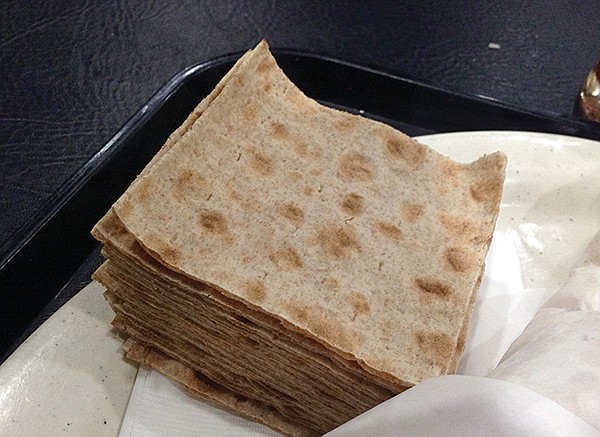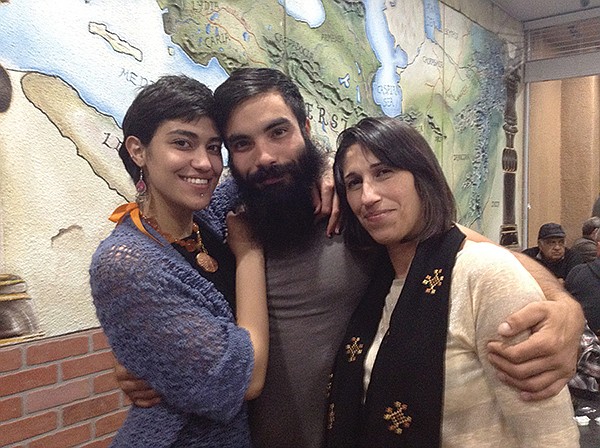 Facebook
Facebook
 X
X
 Instagram
Instagram
 TikTok
TikTok
 Youtube
Youtube

Monday night. It’s always the test. If a place is buzzing this night of the week, they must be doing something right.
Right now, 7 p.m., this is an island of life on a dead street. Clumps of people stand outside this place talking, smoking, arguing. On the patio, guys toss dice onto backgammon tables.
Inside, it’s abuzz, too. Customers yak between slurps of tea from cute glass mugs, eating kebabs and diving into cream and yellow piles of basmati rice. One huge 3-D map of the old Persian Empire dominates the right wall. Shelves of groceries with Iranian food, kettles for boiling tea, and shisha pipes define the left.
From the taxis parked outside, you can see this is a drivers’ hangout.

So, to business. This is Darband. The Persian place. The menu’s two sides of a plastic page. Hmm... Appetizers start at $4 and go to $9. Daily specials go from $15 to $22, and beef and chicken kebab–type dishes are in the same range. But might get away with appetizers.
Actually, I’m looking forward to this, now that I’m here. Persian food is pretty much unexplored territory for me. On the one hand, you can just think kebabs; on the other, you should really be thinking pomegranates and walnuts, lamb, saffron, lush stews. Lots of meat-fruit combos, nuts, and dried fruit. And interesting treatment of veggies such as eggplant. And little sophisticated things they do. Like, the time I went to Sadaf (“The Pearl”) in La Jolla, they gave us raw onion to eat first. Purpose? Sharpen your appetite.
They even stew greens such as spinach and parsley.
So: decisions. First off, I go for an appetizer. I skip the ones like maust-o-khiar, which is basically plain yogurt, chopped cucumber, and mint. It costs $4 for a small, $8 for a large. I’d like the kashk-e-bademjan, sautéed baby eggplant, but it’s $9. Want to save major investment for the main dish.
The one I’d put out the $8 for, though, is tah-deeg. “Crunchy rice topped with stew of the day (when available).” Today, Monday, it’s beef stew. So, I ask for that.
“Not available,” says the guy behind the counter.
Pity. Carla’s friend Zoe told her what ta-deeg is: the crispy layer of saffron rice that gets burnt at the bottom of the pot and which has gotten infused with the caramelized saffron. Sounds delish, especially with the stew on top. Sigh.
Also, I’d love to try their fesenjoon, basically pomegranate purée, walnuts, onions, and chicken chunks or meatballs. Or ghormeh sabzi, stewed greens like parsley and spinach, plus kidney beans, lots of turmeric, and lamb. Or beef. Sabzi’s the national stew of Iran, they say. But that’s a Wednesday special, and it costs $16.

So I go for the tried and true hummus. The good news is the “small” size costs only $4, and that includes the lavash bread. And the super-good news is “small” ain’t small. It’s a generous oval bowl of the creamy sesame tahini-and-garbanzo beans mix.
I also ask for a chicken shish kebab, with marinated chicken, grilled onions, green peppers, zucchini, tomato, and a “special sauce.” That should fill me up. Costs $10.
I go get some water. Spot this teapot next to a hot-water urn. That means one thing. Chai.
“It is free,” says one of the servers. He’s dropping lots of tea bags into the pot. Then he tops it up with hot water. “But just use a little of this tea. It’s very strong.”
So I pour the tea, add the water, then toss in couple of teaspoons of white sugar.
I head over to the table and start slurping.
“Would you like to know how we Persians drink our tea?” says this gal at the next table. Name’s Elham.
“Uh, sure,” I say.
“Okay. Let’s start again.”
She grabs my glass, takes it back to the urn, empties it, washes it out, and refills it with a half inch of tea and the rest with hot water.
“Now,” she says, once she’s back. She puts a friendly hand on my shoulder. “Come and sit with us. I’ll show you how we drink tea in Tehran.”
So we sit down at their table, underneath a big, almost full-color map of the ancient Persian Empire.

“I’m teaching him how to drink tea,” Elham tells the other two, Samara and Adam. “So back in Tehran, what everybody does is this.”
And she grabs a sugar lump from a bowl and puts it in her mouth. Then she takes a drink of the hot chai. “Mmm,” she says.
Huh. I do the same, and when you glug down some of that bitter tea, it suddenly starts sweetening as it goes down. Yeah, okay, sugar...blah-de blah, but it’s a little taste thrill.
Turns out Elham is a nurse. Samara is a writer. Both from Iran. Adam’s from here, even though his beard makes him look positively Biblical.
My hummus and my chicken wrap arrive. The lavash bread is a pile of little three-inch squares. Ideal for collecting puddles of hummus. The chicken wrap is good, really big, and has plenty of stuff in it, including grilled onions and green peppers, although no really distinct taste to it.
“That wrap’s not really Persian,” says Elham. “More fusion, half-American.”
I see the three of them are finishing up an eggplant stew (bademjan, $15) and a kobideh kebab, basically two skewers of seasoned ground beef, served with charbroiled tomato and basmati rice ($14). Dang. Are those the real Persian thing?
“How come they’re so full tonight?” I ask. “I mean, it being Monday night and all.”
“Well, look around you,” she says. “The food, the atmosphere. It’s real. Close your eyes and we could be in Tehran.”
Maybe it’s a Monday thing.
Hours: 10 a.m.–1 a.m., daily (till 2 a.m. Friday, Saturday)
Prices: Maust-o-khiar (yogurt, chopped cucumber, mint), $4 small, $8 large; hummus, lavash bread, $4, $8; kashk-e-bademjan (sautéed baby eggplant), $9; tah-deeg (crunchy rice topped with stew), $8; ghormeh sabzi (stewed greens, lamb, or beef), $16; chicken shish kebab, $10; lamb rack kebab, $22; barg (beef tenderloin, basmati rice), $19; veggie skewer, rice, $8; shish kebab (filet mignon) wrap, $11
Buses: 3, 120
Nearest bus stops: Fifth and Beech (northbound); Fourth and Cedar (southbound)


Monday night. It’s always the test. If a place is buzzing this night of the week, they must be doing something right.
Right now, 7 p.m., this is an island of life on a dead street. Clumps of people stand outside this place talking, smoking, arguing. On the patio, guys toss dice onto backgammon tables.
Inside, it’s abuzz, too. Customers yak between slurps of tea from cute glass mugs, eating kebabs and diving into cream and yellow piles of basmati rice. One huge 3-D map of the old Persian Empire dominates the right wall. Shelves of groceries with Iranian food, kettles for boiling tea, and shisha pipes define the left.
From the taxis parked outside, you can see this is a drivers’ hangout.

So, to business. This is Darband. The Persian place. The menu’s two sides of a plastic page. Hmm... Appetizers start at $4 and go to $9. Daily specials go from $15 to $22, and beef and chicken kebab–type dishes are in the same range. But might get away with appetizers.
Actually, I’m looking forward to this, now that I’m here. Persian food is pretty much unexplored territory for me. On the one hand, you can just think kebabs; on the other, you should really be thinking pomegranates and walnuts, lamb, saffron, lush stews. Lots of meat-fruit combos, nuts, and dried fruit. And interesting treatment of veggies such as eggplant. And little sophisticated things they do. Like, the time I went to Sadaf (“The Pearl”) in La Jolla, they gave us raw onion to eat first. Purpose? Sharpen your appetite.
They even stew greens such as spinach and parsley.
So: decisions. First off, I go for an appetizer. I skip the ones like maust-o-khiar, which is basically plain yogurt, chopped cucumber, and mint. It costs $4 for a small, $8 for a large. I’d like the kashk-e-bademjan, sautéed baby eggplant, but it’s $9. Want to save major investment for the main dish.
The one I’d put out the $8 for, though, is tah-deeg. “Crunchy rice topped with stew of the day (when available).” Today, Monday, it’s beef stew. So, I ask for that.
“Not available,” says the guy behind the counter.
Pity. Carla’s friend Zoe told her what ta-deeg is: the crispy layer of saffron rice that gets burnt at the bottom of the pot and which has gotten infused with the caramelized saffron. Sounds delish, especially with the stew on top. Sigh.
Also, I’d love to try their fesenjoon, basically pomegranate purée, walnuts, onions, and chicken chunks or meatballs. Or ghormeh sabzi, stewed greens like parsley and spinach, plus kidney beans, lots of turmeric, and lamb. Or beef. Sabzi’s the national stew of Iran, they say. But that’s a Wednesday special, and it costs $16.

So I go for the tried and true hummus. The good news is the “small” size costs only $4, and that includes the lavash bread. And the super-good news is “small” ain’t small. It’s a generous oval bowl of the creamy sesame tahini-and-garbanzo beans mix.
I also ask for a chicken shish kebab, with marinated chicken, grilled onions, green peppers, zucchini, tomato, and a “special sauce.” That should fill me up. Costs $10.
I go get some water. Spot this teapot next to a hot-water urn. That means one thing. Chai.
“It is free,” says one of the servers. He’s dropping lots of tea bags into the pot. Then he tops it up with hot water. “But just use a little of this tea. It’s very strong.”
So I pour the tea, add the water, then toss in couple of teaspoons of white sugar.
I head over to the table and start slurping.
“Would you like to know how we Persians drink our tea?” says this gal at the next table. Name’s Elham.
“Uh, sure,” I say.
“Okay. Let’s start again.”
She grabs my glass, takes it back to the urn, empties it, washes it out, and refills it with a half inch of tea and the rest with hot water.
“Now,” she says, once she’s back. She puts a friendly hand on my shoulder. “Come and sit with us. I’ll show you how we drink tea in Tehran.”
So we sit down at their table, underneath a big, almost full-color map of the ancient Persian Empire.

“I’m teaching him how to drink tea,” Elham tells the other two, Samara and Adam. “So back in Tehran, what everybody does is this.”
And she grabs a sugar lump from a bowl and puts it in her mouth. Then she takes a drink of the hot chai. “Mmm,” she says.
Huh. I do the same, and when you glug down some of that bitter tea, it suddenly starts sweetening as it goes down. Yeah, okay, sugar...blah-de blah, but it’s a little taste thrill.
Turns out Elham is a nurse. Samara is a writer. Both from Iran. Adam’s from here, even though his beard makes him look positively Biblical.
My hummus and my chicken wrap arrive. The lavash bread is a pile of little three-inch squares. Ideal for collecting puddles of hummus. The chicken wrap is good, really big, and has plenty of stuff in it, including grilled onions and green peppers, although no really distinct taste to it.
“That wrap’s not really Persian,” says Elham. “More fusion, half-American.”
I see the three of them are finishing up an eggplant stew (bademjan, $15) and a kobideh kebab, basically two skewers of seasoned ground beef, served with charbroiled tomato and basmati rice ($14). Dang. Are those the real Persian thing?
“How come they’re so full tonight?” I ask. “I mean, it being Monday night and all.”
“Well, look around you,” she says. “The food, the atmosphere. It’s real. Close your eyes and we could be in Tehran.”
Maybe it’s a Monday thing.
Hours: 10 a.m.–1 a.m., daily (till 2 a.m. Friday, Saturday)
Prices: Maust-o-khiar (yogurt, chopped cucumber, mint), $4 small, $8 large; hummus, lavash bread, $4, $8; kashk-e-bademjan (sautéed baby eggplant), $9; tah-deeg (crunchy rice topped with stew), $8; ghormeh sabzi (stewed greens, lamb, or beef), $16; chicken shish kebab, $10; lamb rack kebab, $22; barg (beef tenderloin, basmati rice), $19; veggie skewer, rice, $8; shish kebab (filet mignon) wrap, $11
Buses: 3, 120
Nearest bus stops: Fifth and Beech (northbound); Fourth and Cedar (southbound)
Comments